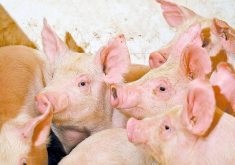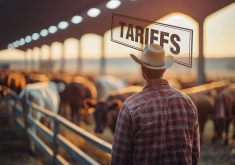Knowing your cattle’s herd instincts and working with them instead of against them can give you peace of mind and make handling easier.
That was the theme of a livestock-handling clinic put on by rancher Dylan Biggs at the recent Ranching Opportunities seminar at Olds College.
Biggs runs anywhere from 200 to 900 cattle at TK ranch in east central Alberta and moves them frequently for rotational grazing. Because he calves during May and June, moving and calving occur during the same time and Biggs looks for ways to make cattle moving more enjoyable and less stressful.
Read Also

Horns aren’t unlocking anytime soon on livestock transport standards
Standards good enough meet the definition of “humane” animal transportation still vary widely between what what industry wants, what animal rights advocates want and, between the two, what federal regulators decide is good enough.
“When we get in the position where we’re behind these cattle and we’re starting to use our bodies, fear, and force to get the job done, the cattle don’t respond very well,” he said. “It’s hard on the facilities, it’s hard on the cattle, and it’s hard on people and relationships.”
Safe and effective livestock handling requires an understanding of herding dynamics and how to gently apply pressure to cattle. Biggs quoted Temple Grandin, who said that cattle are more afraid of fear than they are of humans.
Cattle can be unmanageable in two different scenarios, said Biggs.
“There are those cattle that are so quiet that they won’t move, and there are those cattle that are so absolutely terrified that you can’t get close,” he said. “If we’re going to make this thing work, we have to bring it to the middle where we have a balance of respect and trust.
“Those cattle that are terrified of us have to trust us so that we can work with them. The last thing we want to do is make them more afraid.”
When handling animals, Biggs looks to see if they seem nervous and takes the time to make sure that they become comfortable with his approach. He can tell an animal is more relaxed if it turns away from him with its head down, but doesn’t speed up or run when he is approaching.
“You need your cattle to be in a certain mind frame,” he said. “If you resort to fear and make cattle afraid, then they’re really hard to handle. If you establish trust as your foundation, then you can do other things and it becomes easier, relatively.”
Pairs are harder
Moving pairs is one of the hardest things to do, said Biggs, who moves two-day-old pairs in a rotational grazing system. When cows and calves are already paired before moving, he doesn’t have to worry about as many calves running back to the original pasture. Once paired and settled, he can efficiently move the cattle in a loose pack. He waits until there is no bawling and tries to keep them in a single file as young cattle in particular become agitated if there is a congested pack pushing to get through the gate. He has one handler in the front, and will pair cattle up to three or four times depending on the length of a move. Biggs believes pairing cattle up multiple times can make the process easier, and will save time in the long run.
Apply pressure on the sides, he advised.
“By virtue of human nature, we like to be behind stock and we like to push stock,” he said. “One of the things that we need to do is get a little bit more flexible relative to our position on a herd or on a single animal. If cattle don’t trust you, the surest way to make them more nervous is get behind them, where they can’t see you, and push them.”
Producers can use pressure on the sides of a herd, even if they happen to be on the back end of a herd, but it’s best if the handler can stay in an area where the lead cattle can see them.
“One thing that you need to do when herding is pay attention to the whole herd,” he said. “A lot of times, there’s going to be something going on at the front.”
Biggs said it is also human nature to cut an animal off, but it’s best to anticipate the way that the animal is going to move and apply pressure to keep them in the flow.
“We need to learn to be a bit different with our positions sometimes,” he said.
———
“Youneedyourcattletobeinacertainmindframe.Ifyouresorttofearandmakecattleafraid,thenthey’rereallyhardtohandle.”
DYLAN BIGGS
———
“Cattle are more afraid of fear than they are of humans.”















